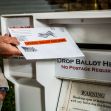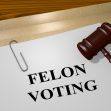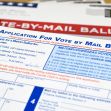The U.S. Constitution lays out some bare guidelines for voting in elections, but states carry most of the weight themselves. The Constitution does not guarantee voting as a right, exactly, and the consequences of that omission have rippled over the years. According to Section 2 of Article IV, states are responsible for the “Times, Places, and Manner of holding Elections,” leaving a sizeable legal chasm to fill with varying procedures.
State by state, the particulars are fraught with hurdles. Hundreds of thousands of mail-in ballots are discarded nationwide each election due to basic blunders such as forgotten or slightly dissimilar signatures and missed deadlines. Sometimes, the votes are mailed on time but arrive too late to qualify.
The modern epitome of “spoiled” ballots traces back to the year 2000: the first presidential election for the 21st century, in which one state—Florida—decided the general election. The election indirectly distinguished voting as a privilege rather than a right in the resulting Supreme Court case, Bush v. Gore, that decided the winner. As a whole, it was a culmination of election process shortcomings in the U.S.
It came to light that thousands of ballots in Florida had been erroneously discounted—with the Supreme Court’s decision solidifying that mistake into a daunting precedent for this year’s turbulent political battle.
Florida’s state-mandated recount was halted, leaving only 537 ballots to award the state’s final electoral votes. The errors were plentiful: disjointed county-by-county regulations, confusing directions, and faulty machines—horrifyingly faulty machines, in fact. Ballots were muddied with a hole-punch system rife with faults. Additionally, it was surmised that 12,000 Floridian votes had been tossed out solely because the counting machines had discredited the voters as convicted felons—at the time, it was illegal for a felon to participate in state or federal elections in the state. Not that those were felons voting, anyway.
If felons had been allowed participation, studies suggest Al Gore would likely have won the state by a wide margin and secured the presidency. But the disenfranchisement of those some-800,000 voters was merely an additional hypothetical cog in the flawed engine of the 2000 election.
Unfortunately, Florida’s ballot troubles were not a single-state novelty: beyond America’s panhandle, the democratic process had still yet to be streamlined in a majority of states. Many had less-publicized versions of the same technical and mechanical ballot issues. Georgia, Idaho, Illinois, South Carolina, and Wyoming experienced comparable problems—some were even more severe than Florida’s.
Across the nation, between four and six million votes were estimated lost in the 2000 general election. Equipment failures were responsible for close to two million rejected ballots. About one million were lost due to operational difficulties encountered at the polls. Another 1.5 to three million went uncounted for registration issues.
Now, two full decades after the nation’s most notorious stain on the election process, how much has changed?
A popular vote ended Florida’s felon disenfranchisement in 2018, but Governor Rick Scott implemented rules that some view as akin to poll taxes. It ensured the disqualification of hundreds of thousands of potential voters, already granting another opportunity for the state to lead by example in confusion and ballot disposals.
Technology, at least, has developed since the Floridian debacle 20 years ago. Implemented with high hopes that another 36-day wait for election results can be avoided, Congress passed the Help America Vote Act of 2002 (HAVA) to provide direct funding to update states’ voting equipment and implement federal guidance for structure. The nation began moving away from punch cards and levers to instead utilize a standardized test-type of electronic scanning.
There is still some argument for more traditional machine counting systems, but mail-in ballots, in particular, are almost entirely tallied by these more modern optical scanners.
HAVA also created the U.S. Election Assistance Commission to distribute the funding and bring the voting process out of the digital dark ages. Other than the Military and Overseas Voter Empowerment Act of 2009 (MOVE), no significant bills have passed to modernize American voting. The HAVA commission’s “pot” of funding has long been expended, and Congress has not brought about new legislation since.
Using the 2000 election as an example, the technology updates should at least cut the number of “spoiled” ballots in half by now, and that’s before accounting for registration and polling location problems that still exist but have presumably undergone enough improvement. Yet even the newer technology still spurs a multitude of problems, and other factors clearly have not improved enough: the 2016 general election still left close to two million ballots cast but uncounted, according to the U.S. Elections Assistance Commission.
This time, it was Michigan instead of Florida that held the ultimate electoral swing to secure the 2016 presidential race. The state awarded Donald Trump his required lead by just under 11,000 ballots in the state. However, over 75,000 ballots in Michigan (mostly from Detroit, where 87 ballot machines broke down in one precinct) were rejected for technical issues. Pennsylvania and Wisconsin produced similarly stark post-election evaluations.
For months, Mr. Trump has been calling out potential fraud with mail-in voting; in reality, ballots are at a far higher risk for technical issues than fraud. Trump even directed a commission in 2017 to investigate voter fraud, only to disband it after less than a year with no findings. Furthermore, the Heritage Foundation examined 36 years of mail-in ballots. The right-wing group analyzed over two billion votes cast and found the rate of fraud to be .0000007 percent.
Instead, voters are met with fire-lit hoops of complications to ensure their nation recognizes their participation in democracy.
This year’s state primaries and caucuses have already been an ominous indication of what may happen on November 3. Wisconsin’s primary in April made unsettling headlines with nearly 80,000 ballots on the verge of rejection for being received after Election Day. These votes were saved only by their happenstance adherence to an emergency counting period the state had extended for six days beyond the official deadline. Wisconsin also disregarded another 14,000 mail-in votes because the voters had not acquired witness signatures along with their own.
A lower court in Wisconsin ordered a similar six-day emergency extension for mail-in ballots for the upcoming general election, but a federal judge reversed the order on October 9, saying the extension was issued too close to Election Day. Like many states, Wisconsin will only count mail-in votes received by the time the physical polls close on November 3.
Like Florida in 2000, Wisconsin is merely a standout example of the national state of election procedural weaknesses. Nationwide, it is estimated that close to 600,000 mail-in ballots (at least) were rejected this year during caucuses and primaries. At least 65,000 were excluded due to missed deadlines, despite voters adhering to the rules on their end. Several tens of thousands more were tossed out for mere signature discrepancies.
The COVID-19 pandemic has thrown an additional ax into an already subpar system. From 2004 to 2016, the number of votes cast in the mail more than doubled; 16 states received more than 50 percent of their total votes as absentee or mail-in ballots.
This year’s numbers are expected to make those surges seem small. Already at the time of writing, over nine million ballots have been cast across the country, either in the mail or by way of early voting.
State and federal officials are already in courts to dispute the merits of post-COVID-19 voting laws. Ballots sent in the mail are expected to number in the tens of millions for the 2020 general election, tentatively predicted to land at around 60 million.
Even one percent of that amount could equate to hundreds of thousands of rejected constituents or more. Some studies estimate up to one or two million discarded ballots, depending on the number of voters utilizing mail-in and early voting options.
Lawsuits are sprouting up like weeds throughout the states. Democrats rally for expanded mail-in ballots, eager for improved voter safety measures and accessibility. Republicans vie for stricter constraints to narrow the path for absentee and mail-in ballots. The latter party cites fear of misuse or even fraud; they have already dumped around $20 million into battling Democratic calls for broader voter inclusions.
Similar to Bush v. Gore but with unparalleled scope, the Supreme Court is expected to again step in to help navigate justice for the 2020 election. An important factor: it is not only the currently seated Court who will be familiar with the 2000 precedent. Judge Amy Coney Barrett, Trump’s nominee for the open Supreme Court seat, assisted on George W. Bush’s legal team at the time. She told the Senate Judiciary Committee that she no longer possesses records detailing the extent of her work on the case.
Barrett would be the second Trump-appointed Justice involved on Bush’s behalf in 2000. Justice Brett Kavanaugh, too, traveled to Florida to join the fight against the recount. Chief Justice John Roberts, who was appointed by President Bush in 2005, journeyed to Florida as well to offer legal counsel in Bush’s favor.
This year is sure to boast an election worthy of comparison to the 2000 race (a deeply unfortunate kinship to have). Despite widespread technology updates and initial federal response to the disarray of the time, it is clear that the past 20 years have not taught the country the needed lessons. Rather, it seems the election obstacles will again be addressed only during and after the coming disarray—perhaps too late to avoid a nation disheartened in its government.






